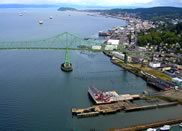|
Astoria Oregon Bicentennial
John Jacob Astor
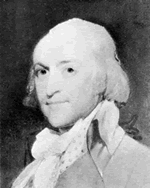 John Jacob Astor was not born a wealthy fur trader. Instead, he was born in Baden, Germany in 1763, the third son of a butcher. One brother, Henry, left for New York, while another, George, travelled to London to open up business in musical instruments. John followed his brother George first, working with him in London. However, in 1783, Astor left for New York, whre, during the voyage, he met another immigrant who told him about prosperous fur trading opportunities in America. Astor was in New York by 1784, married in 1785, and had opened a shop by 1786. He would purchase furs and sell musical instruments of his brother's initially. Soon, Astor established connections in the rising industry, and, along with Montreal fur traders, began to look East to the Orient, whre American furs were in high demand. This is where the story of Astoria begins to take shape. John Jacob Astor was not born a wealthy fur trader. Instead, he was born in Baden, Germany in 1763, the third son of a butcher. One brother, Henry, left for New York, while another, George, travelled to London to open up business in musical instruments. John followed his brother George first, working with him in London. However, in 1783, Astor left for New York, whre, during the voyage, he met another immigrant who told him about prosperous fur trading opportunities in America. Astor was in New York by 1784, married in 1785, and had opened a shop by 1786. He would purchase furs and sell musical instruments of his brother's initially. Soon, Astor established connections in the rising industry, and, along with Montreal fur traders, began to look East to the Orient, whre American furs were in high demand. This is where the story of Astoria begins to take shape.
Astor, in the late 1790s, paid great attention to the stirrings of Peter Pond, Alexander Mackenzie and other "prophets" who foretold the possible benfits of a western trade empire. He also met Alexander Henry, a businessman in Montreal, who furthered his education concerning the ideas of western trading posts. As Astor began to formulate how he could cash in on this opportunity, it became clear that the plan was not exclusively financial and technical, but political as well. Thus Astor would have to court local and national governmants, as welll as fur companies of America and Canada.
His first connection came with New York Governor DeWitt Clinton, nephew of the Vice President. Astor revealed to Clinton his plan of a chain of fur trading posts in the Pacific Northwest. He didn't meet with Clinton, though, just to talk. He wanted first the approval and chartering of his comapny, the Pacific Fur Company. The charter was granted him in April of 1809. What he was mostly after, though, was the affect that Governor Clinton could impose on his uncle, the vice president. Astor wanted "approbation" from the federal government, a fairly vague term which meant full or part approval. Astor realized that in such a venture he would want governmental approval and protection. He recieved some help in 1808 when his letter was delivered to Vice President Clinton. Now Astor could move farther up in the government ranks in his seeking of approbation.
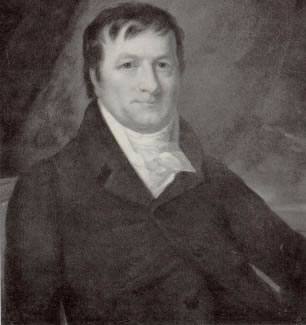 Astor's next step was to meet with President Jefferson, which he did in summer of 1808 in Washington, DC. Jefferson promised "general support", and also that of protection from hostile actions of the North West company. In the fall, Astor went to Montreal, where he hoped to buy the Michilimackinac Company, which trapped in the Great Lakes region. He wanted to create a boundary line with Canadian fur traders - with control of this company he could be in control of the southern Great Lakes areas. However, his offer was rejected. Stern competition would continue with the Canadians. Astor's next step was to meet with President Jefferson, which he did in summer of 1808 in Washington, DC. Jefferson promised "general support", and also that of protection from hostile actions of the North West company. In the fall, Astor went to Montreal, where he hoped to buy the Michilimackinac Company, which trapped in the Great Lakes region. He wanted to create a boundary line with Canadian fur traders - with control of this company he could be in control of the southern Great Lakes areas. However, his offer was rejected. Stern competition would continue with the Canadians.
By 1809 the North West Company was back to their old ways by sending explorers to the west after a few years of inactivity. Simon Fraser and David Thompason both ventured west, and Astor forced himself to act in response to these activities. His plan was for a ship to sail to the mouth of the Columbia first, build a fort and then be joined by an overland party which would depart from St. Louis. He panned for Wilson Price Hunt to lead this overland group - leaving as soon as spring of 1810. Hunt was a man fascinated with the west, a merchant who had met Lewis and Clark. Astor would need more governmental support.
Astor wrote a letter to Secretary of the Treasury Gallatin, which in turn was read to Secretary of War Eustis and eventually President Madison. He asked for increased support and recognition of his Pacific Fur Company. However, Washington promised only "economic nationalism", meaning that they would go no further than they had already in supporting Astor. Thus, Astor ventured to Montreal to see if a deal could be made with the North West Company. In Fall of 1809 a cooperation of mutual interest was attempted, but the deal fell through. Astor would have to act almost entirely on his own.
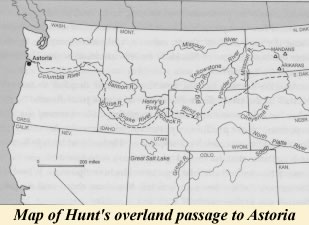 However, soon after Astor hired three North West men to be members on the expedition. These men arrived in New York in March 1810. The rest of the men were hired and signed the Articles of Agreement, which included the goals and responsibilities of the Astorians. The main goal was for a fort at the mouth of the Columbia, and accompanying trading posts in the region. With his plan coming together, Astor once again sought support. No Canadian support came. However, in July 1810, when the plan was aready in action, the North West company accepted his deal and sent David Thompson to meet the Astorians with a partners in cooperation plan. However, this plan would never really develop, as the Astorians were well along in their own dealings when Thompson arrived in July, 1810. However, soon after Astor hired three North West men to be members on the expedition. These men arrived in New York in March 1810. The rest of the men were hired and signed the Articles of Agreement, which included the goals and responsibilities of the Astorians. The main goal was for a fort at the mouth of the Columbia, and accompanying trading posts in the region. With his plan coming together, Astor once again sought support. No Canadian support came. However, in July 1810, when the plan was aready in action, the North West company accepted his deal and sent David Thompson to meet the Astorians with a partners in cooperation plan. However, this plan would never really develop, as the Astorians were well along in their own dealings when Thompson arrived in July, 1810.
In early 1810 the final piece of the Astoria plan came into place. This was Astor's dealings with the Russians of the Pacific coast. As early was the 1780s, Russian "promyshlenniks" (fur hunters) had been in Alaska. These voyages were led by Gregorii Shelikhov. However, Catherine the Great never really saw the value of Russian assertion in the Pacific fur regions. By 1797, though, the various Russians dealing in furs merged to form the United American Comapny, and in 1799 Emperor Paul formed a twenty year monopoly with the fur traders under the name of the Russian American Comapany. A colony at New Archangel (Sitka, Alaska) was led by Alexander Baranov. In fall of 1809 Baronov met with Astor to deal. Indians had been harassing the Russians with weapons attained from the seventy two American ships which traded in the Pacific from 1787 to 1806. Baronov also was unable to trade with China. Astor proposed that the Russians and Americans squeeze the British out of the west. There was little Astor could do about the Indians, but, in return for Baronov's cooperation, he would deliver New Archangel supplies, then carrying their furs to the East (under American flags) and trade the furs in the Orient for a higher profit. In 1811 Astor sent son in law Adrian Benton to St. Petersburg, who rejected the plan. Astor would decide to then deal directly with the Russian American Company. The final plan called for cooperation between Astor and Baronov's traders, no selling of Astorian weapons to the Indians, a monoploy on Astor's supplies being purchased by the Russians, and Astor's carrying of the Russian furs to Canton, China. This plan was finally approved in late 1812. But before all of these plans could become reality, Astor would have to establish his fort at the Columbia.
By spring 1810 the expeditions were being put together. Wilson Price Hunt met in Montreal to choose men. Two other leaders of the overland party were McKay and Donald Mackenzie. Clerks were needed. Thus Gabriel Franchere and Alexander Ross were hired. This expedition, the first American of its kind since Lewis and Clark, left Montreal in July of 1810 as a party of 16. They travelled through the Great Lakes, down the Mississippi, and to St. Louis, their "jumping off" point. Leaving in March of 1811, the crew followed Lewis and Clark's route for a bit but opted for a southern pass through the continental divide. Their hardships were evident the whole trip, as they had to eat horsemeat at the Snake River junction. Travelling down the Columbia, the men arrived to find a fort built at Astoria, the mouth of the Columbia. They had finished the journey in Febuary of 1812. The seaward contingent had arrived much earlier.
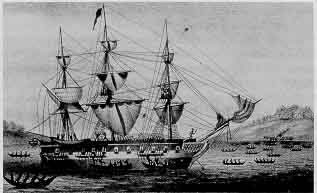 Astor purchased his sailing vessel, the Tonquin, in August of 1810 for $37,860. It was 94 feet long, 25 feet wide, and 12 feet deep. Having two Pacific voyages to it's name, Astor thought he had made a wise decision. He hired Captain Jonathan Thorn to lead. Thorn, a hot tempered Navy lieutenant, would prove to be an able yet negative aspect of the trip. The relations between him and the men were poor at best. Along with the sailing Astorian laborers were four specialized men: Johann Koaster, a carpenter, George Bell, a cooper, Job Aitkem, a boat builder, and Augustus Roussel, a blacksmith. Astor purchased his sailing vessel, the Tonquin, in August of 1810 for $37,860. It was 94 feet long, 25 feet wide, and 12 feet deep. Having two Pacific voyages to it's name, Astor thought he had made a wise decision. He hired Captain Jonathan Thorn to lead. Thorn, a hot tempered Navy lieutenant, would prove to be an able yet negative aspect of the trip. The relations between him and the men were poor at best. Along with the sailing Astorian laborers were four specialized men: Johann Koaster, a carpenter, George Bell, a cooper, Job Aitkem, a boat builder, and Augustus Roussel, a blacksmith.
The Tonquin departed New York Harbor in September, 1810. An escort was requested for protection from British ships who had been impressing American sailors, but the actual outcome of this request remains a mystery. While some of the men claim that the USS Constitution escorted them, nowhere in the Constitution's manifest is this evident. The voyage was unpleasant for the men. Thorn especially hated the Canadians, and thought the clerk's journals were secret enemy documents. Thus, the men, many of whom were Scots Irish, spoke amongst themselves in either French or Scots Irish, neither of which Thorn could understand.
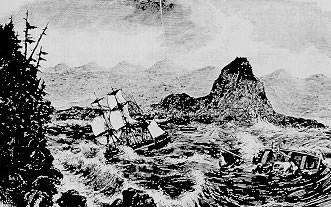 By December 1810 they were around the Cape Horn of South America. By Febuary of 1811 they were in Hawaii, the normal breaking point of the journey. There they met and traded with King Kamehameha. The ship was restocked with supplies, and goats, pigs, and other livestock were purchased. Twelve Hawaiians were signed up for service at Astoria. The Tonquin left Hawaii in March, and by March 22 was at the mouth of the Columbia. The mouth of the Columbia is an extremely dangerous place for large vessels. The colliding of the river and ocean creates a punchbowl of high waters. High winds contribute to turbulent seas, and sandbars make navigation a nightmare. The Columbia claimed the lives of eight Astorians before the fort was even established. John Fox, leading a longboat crew into the river towards land, capsized and drowned. By December 1810 they were around the Cape Horn of South America. By Febuary of 1811 they were in Hawaii, the normal breaking point of the journey. There they met and traded with King Kamehameha. The ship was restocked with supplies, and goats, pigs, and other livestock were purchased. Twelve Hawaiians were signed up for service at Astoria. The Tonquin left Hawaii in March, and by March 22 was at the mouth of the Columbia. The mouth of the Columbia is an extremely dangerous place for large vessels. The colliding of the river and ocean creates a punchbowl of high waters. High winds contribute to turbulent seas, and sandbars make navigation a nightmare. The Columbia claimed the lives of eight Astorians before the fort was even established. John Fox, leading a longboat crew into the river towards land, capsized and drowned.
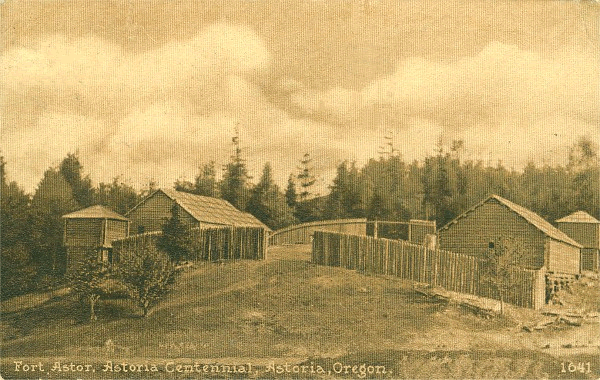 The Astorians met the Chinook Indians and thus trade began. The fort site was selected, a fort erected, and thus Astoria was established. It would be almost a year until the overland crew would arrive and Astoria would be at full force. Despite the hardships that both the overland and seaward expeditions endured, both arrived at Astoria in shape enough to carry on their business enterprise. However, the stormy beginnings of Astoria would be a foreboding of things to come. The Astorians met the Chinook Indians and thus trade began. The fort site was selected, a fort erected, and thus Astoria was established. It would be almost a year until the overland crew would arrive and Astoria would be at full force. Despite the hardships that both the overland and seaward expeditions endured, both arrived at Astoria in shape enough to carry on their business enterprise. However, the stormy beginnings of Astoria would be a foreboding of things to come.
Page credit goes to Will Kalenius, visit source
|
|


